1998 GMC SIERRA fuel
[x] Cancel search: fuelPage 11 of 452
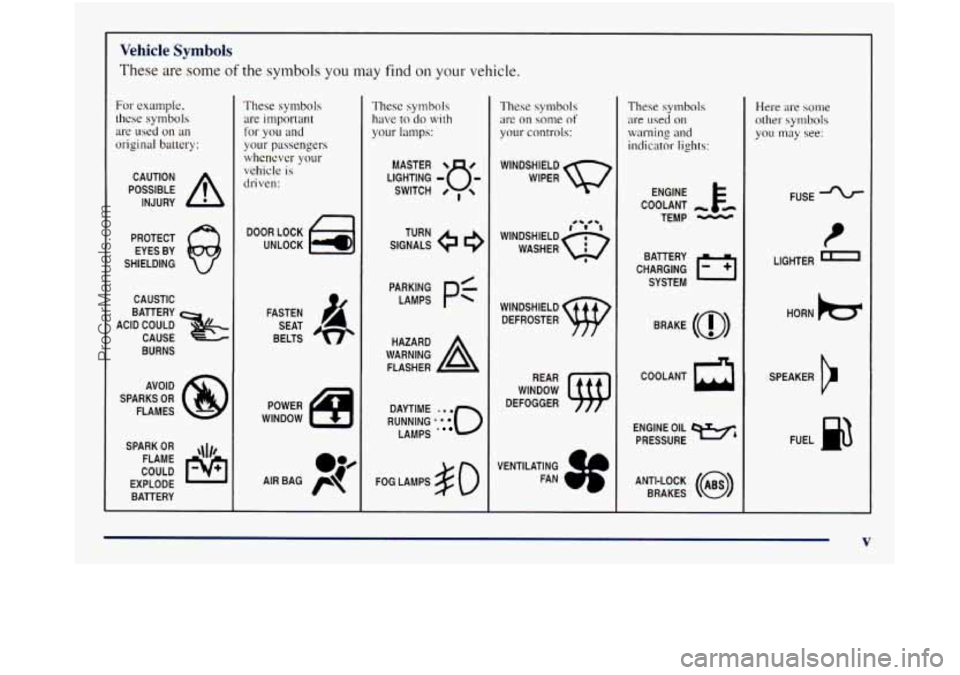
Vehicle Symbols
These are some of the symbols you may find on your vehicle.
For example.
these symbols are used
on an
originnl battery:
POSSIBLE A
CAUTION
INJURY
PROTECT EYES BY
SHIELDING
CAUSTIC
ACID COULD
BATTERY
CAUSE
BURNS
AVOID
SPARKS
OR
FLAMES
SPARK
OR ,\I/,
COULD FLAME
EXPLODE BATTERY
These symbols are important
for you
and
your passengers whenever your
vehicle is
driven:
DOOR LOCK
UNLOCK
FASTEN SEAT
BELTS
POWER
WINDOW
These symbols
have to do with
your lamps:
SIGNALS e e
TURN
RUNNING
*'***'O
DAYTIME LAMPS
*
FOG LAMPS # 0
These symbols
are on some of
your controls:
WIPER Q
WINDSHIELD
DEFROSTER
WINDOW
DEFOGGER
VENTILATING FAN
These symbols
are used on
warning and
indicator lights:
ENGINE k
COOLANT - td
TEMP -
CHARGING BATTERY
SYSTEM
BRAKE
(@)
rr
ENGINE OIL w,
PRESSURE
ANTI-LOCK
(@)
BRAKES
Here are some
other symbols
you may see:
FUSE -%-
t
LIGHTER
HORN
)tr
SPEAKER
b
FUEL no
V
ProCarManuals.com
Page 94 of 452

Passlock@ New Vehicle “Break-In”
Your vehicle is equipped with the Passlock
theft-deterrent system.
Passlock is a passive theft-deterrent system. The
system
is armed once the key is removed from the ignition.
Passlock enables fuel if the ignition lock cylinder
is
turned with a valid key. If a correct key is not used, f~lel
is disabled.
During normal operation, the
SECURITY light will go
off after the engine is started.
If the engine stalls and the SECURITY light flashes.
wait
until the light stops flashing before trying to restart
the engine. Remember to release the key from the
START position as soon as the engine starts.
If you are driving and the SECURITY light comes on, you
will be able to restart the engine
if you turn the engine off.
However, your Passlock system is not working properly
and must be serviced by your dealer. Your vehicle is not
protected by Passlock at this time,
You may also want to
check the fuse (see “Fuses
and Circuit Breakers” in the
Index), See your dealer for service.
If the SECURITY light comes on while the engine is
running, a problem has been detected and the system
may need service. See your dealer for service.
In an emergency, call the Roadside Assistance Center.
NOTICE:
Your vehicle doesn’t need an elaborate
“break-in.” But it will perform better in the long
run if you follow these guidelines:
0
0
0
0
Keep your speed at 55 mph (88 kmh) or
less for the first
500 miles (805 km).
Don’t drive at any one speed
-- fast or
slaw
-- for the first 500 miles (805 km).
Don’t make full-throttle starts.
Avoid making hard stops for the first
200 miles (322 km) or so. During this time
your new brake linings aren’t yet broken
in. Hard stops with new linings can mean
premature wear and earlier replacement.
Follow this breaking-in guideline every
time you get new brake linings.
Don’t tow
a trailer during break-in.
See “Towing
a Trailer” in the Index for
more information.
ProCarManuals.com
Page 98 of 452
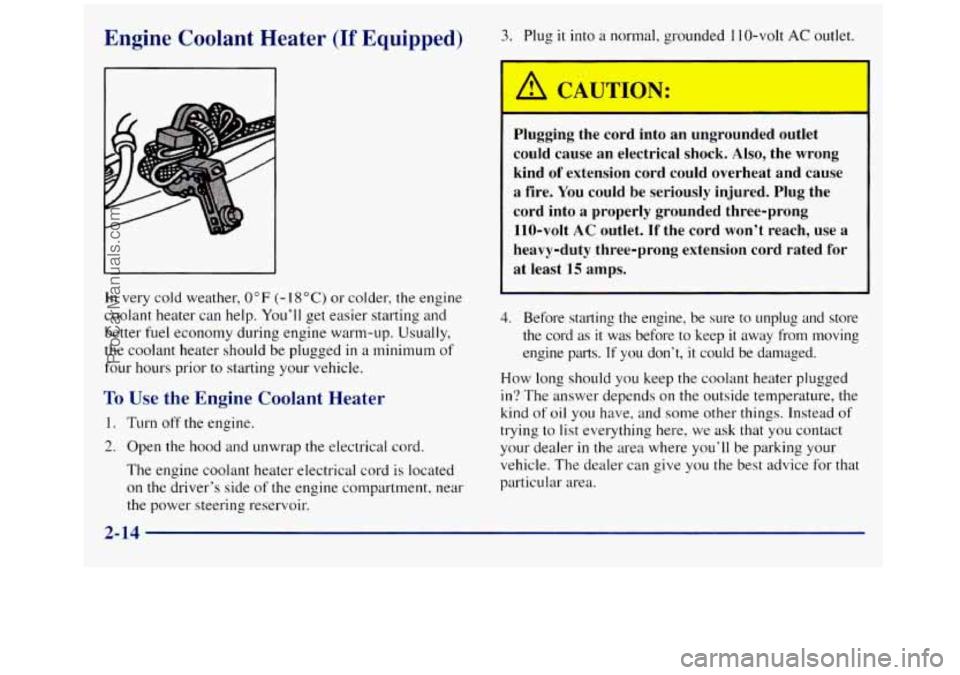
Engine Coolant Heater (If Equipped)
In very cold weather, 0°F (- 1 SOC) or colder, the engine
coolant heater can help. You’ll get easier starting and
better fuel economy during engine warm-up. Usually,
the coolant heater should be plugged in a minimum of
four hours prior to starting your vehicle.
To Use the Engine Coolant Heater
1. Turn off the engine.
2. Open the hood and unwrap the electrical cord.
The engine coolant heater electrical cord
is located
on the driver’s side
of the engine compartment, near
the power steering reservoir.
3. Plug it into a normal, grounded 110-volt AC outlet.
Plugging the cord into an ungrounded outlet
could cause an electrical shock.
Also, the wrong
kind
of extension cord could overheat and cause
a fire. You could be seriously injured. Plug the
cord into a properly grounded three-prong 110-volt
AC outlet. If the cord won’t reach, use a
heavy-duty three-prong extension cord rated for
at least
15 amps.
4. Before starting the engine, be sure to unplug and store
the cord
as it was before to keep it away from moving
engine parts.
If you don‘t, it could be damaged.
How long should you keep the coolant heater plugged
in? The answer depends on the outside temperature, the
kind of
oil you have, and some other things. Instead of
trying to list everything here, we ask that you contact
your dealer
in the area where you‘ll be parking your
vehicle. The dealer can give
you the best advice for that
particular area.
ProCarManuals.com
Page 101 of 452

AUTOMATIC OVERDRIVE (@): This position is
for normal driving.
If you need more power for passing,
and you’re:
Going less than about 35 mph (56 kndh), push your
accelerator pedal about halfway down.
0 Going about 35 rnph (56 kndh) or more. push the
accelerator
all the way down.
You’ll shift down to the next gear and have more power.
AUTOMATIC OVERDRIVE
(@) can be used when
towing
a trailer. carrying a heavy load, driving on steep
hills or for off-road driving. You may want
to shif’t the
transmission to
THIRD (3) or. if necessary, a lower gear
selection
if the transmission shifts too often.
THIRD (3): This position is also used for norrnal
driving, however
it offers more power and lower fuel
economy than AUTOMATIC OVERDRIVE
(@).
SECOND (2): This position gives you more power but
lower fuel economy. You can use SECOND (2) on hills.
It can help control your speed as you go clown steep
mountain
roads, but then you would also want to use
your brakes off and on.
If you manually select SECOND (2), the transmission will
drive
in second gear. You may use this feature for reducing
torque to the
rex wheels when you are trying to start your
vehicle from
a stop on slippery road surfaces.
FIRST (1): This position gives you even Inore power
(but lower fuel economy) than SECOND (2). You can
LIS~ it on very steep hills, or in deep snow or mud. If the
selector lever is put
in FIRST (1 j while the vehicle is
moving forward, the transmission won’t shift into first
E war until the vehicle is going slowly enough.
NOTICE:
If your rear wheels can’t rotate, don’t try to
drive. This might happen if you were stuck in
very deep sand
or mud or were up against a solid
object. You could damage your transmission.
Also, if you stop when going uphill, don’t hold
your vehicle there with only the accelerator
pedal. This could overheat and damage the
transmission. Use your brakes or shift into
PARK (P) to hold your vehicle in position on
a hill.
2-17
ProCarManuals.com
Page 104 of 452
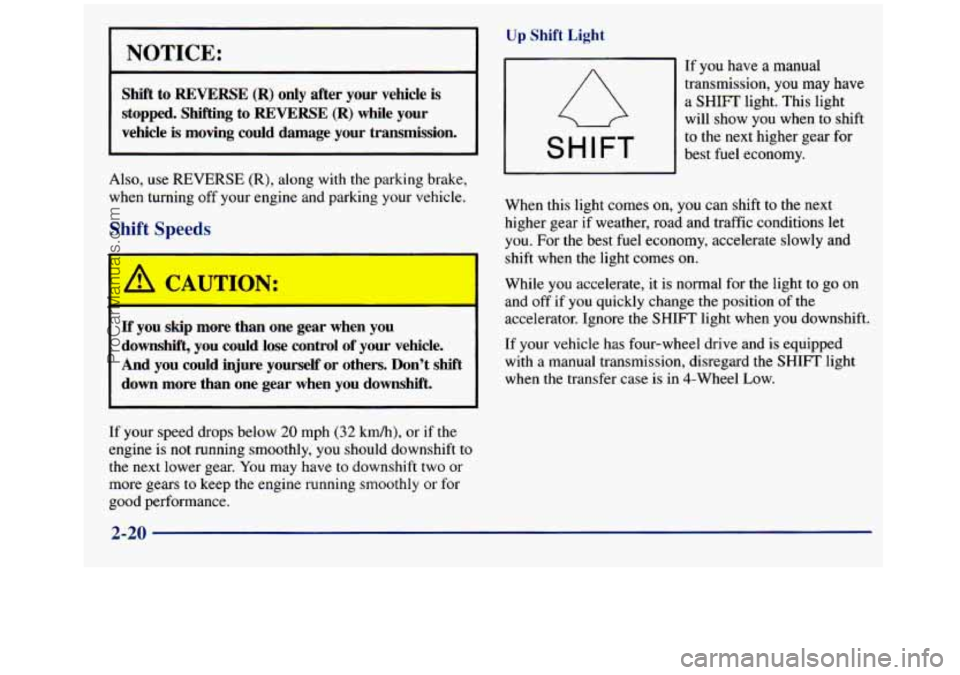
NOTICE:
Up Shift Light
4l
If you have a manual
Shift to REVERSE (R) only after your vehicle is transmission, you may have
a SHIFT light. This light
stopped. Shifting to REVERSE (R) while your
vehicle is moving could damage your transmission. will show you when to shift
best fuel economy.
to the next higher gear for
SHIFT
AI - - , use REVERSE (R), along with the parking brake,
when turning
off your engine and parking your vehicle.
Shift Speeds
I JOU skip more than one gear when you
downshift, you could lose control
of your vehicle.
And you could injure yourself or others. Don’t shift
down more than one gear when you downshift.
If your speed drops below 20 mph (32 kmh), or if the
engine
is not running smoothly, you should downshift to
the next lower gear. You may have to downshift two or
more gears to keep the engine running smoothly or for
good performance. When
this light comes on,
you can shift to the next
higher gear if weather, road and traffic conditions let
you. For the best fuel economy, accelerate slowly and
shift when the light comes on.
While
you accelerate, it is normal for the light to go on
and
off if you quickly change the position of the
accelerator. Ignore the
SHIFT light when you downshift.
If your vehicle has four-wheel drive and
is equipped
with a manual transmission, disregard the SHIFT light
when
the transfer case is in 4-Wheel Low.
I
2-20
ProCarManuals.com
Page 107 of 452
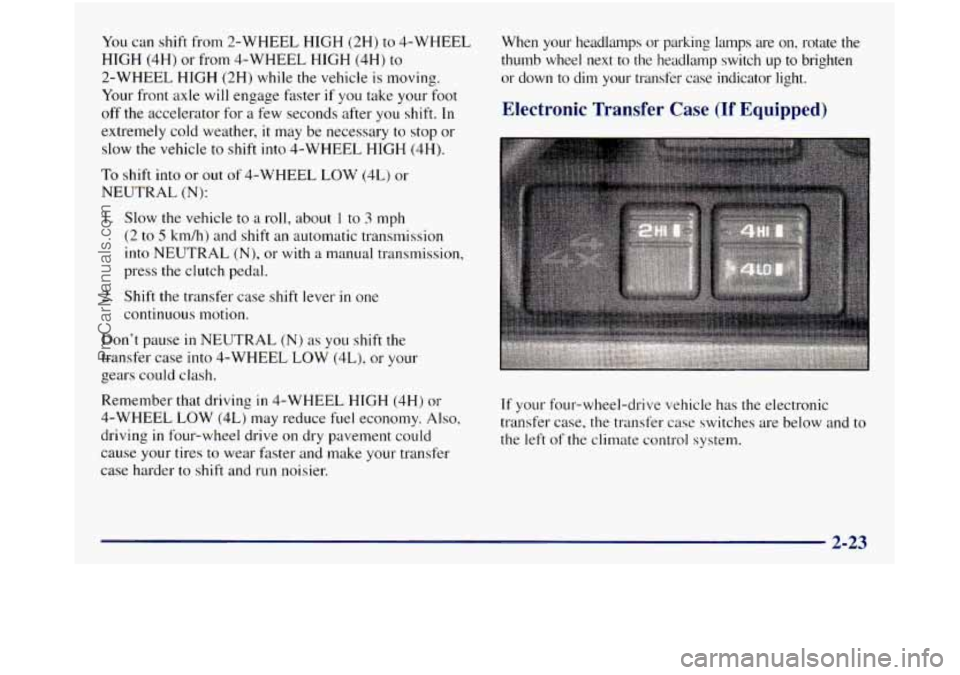
You can shift from 2-WHEEL HIGH (2H) to 4-WHEEL
HIGH (4H) or from 4-WHEEL HIGH (4H) to
2-WHEEL HIGH (2H) while
the vehicle is moving.
Your front axle will engage faster
if you take your foot
off the accelerator for a few seconds after you shift. In
extremely cold weather, it may be necessary to stop or
slow the vehicle
to shift into 4-WHEEL HIGH (4H).
To
shift into or out of 4-WHEEL LOW (4L) or
NEUTRAL
(N):
1. Slow the vehicle to a roll, about 1 to 3 mph
(2
to 5 km/h) and shift an automatic transmission
into NEUTRAL
(N), or with a manual transmission,
press the clutch pedal.
2. Shift
the transfer case shift lever in one
continuous motion.
Don’t pause
in NEUTRAL (N) as you shift the
transfer case into 4-WHEEL LOW (4L), or your
gears
could clash.
Remember that driving
in 4-WHEEL HIGH (4H) or
4-WHEEL LOW (4L) may reduce
fuel economy. Also,
driving
in four-wheel drive on dry pavement could
cause your tires to wear faster and make your transfer
case harder
to shift and run noisier. When your headlamps
or parking lamps are on, rotate the
thumb wheel next
to the headlamp switch up to brighten
or down to dim your transfer case indicator light.
Electronic Transfer Case (If Equipped)
If your four-wheel-drive vehicle has the electronic
transfer case,
the transfer case switches are below and to
the left of the climate control system.
2-23
ProCarManuals.com
Page 146 of 452

Instrument Panel Cluster
CHECK
GAGES SECURITY
MPH
lolololo1 TRIP loo 0 0 oolol
LOCK ANTI -
I APPLY BRAKE TO SHIFT FROM PARK I
United States version shown, Canada similar
Your instrument cluster is designed to let you know at a glance how your vehicle is running. You'll know how fast you're
going, about
how much fuel you have and many other things you'll need to know to drive safely and economically.
2-62
ProCarManuals.com
Page 153 of 452
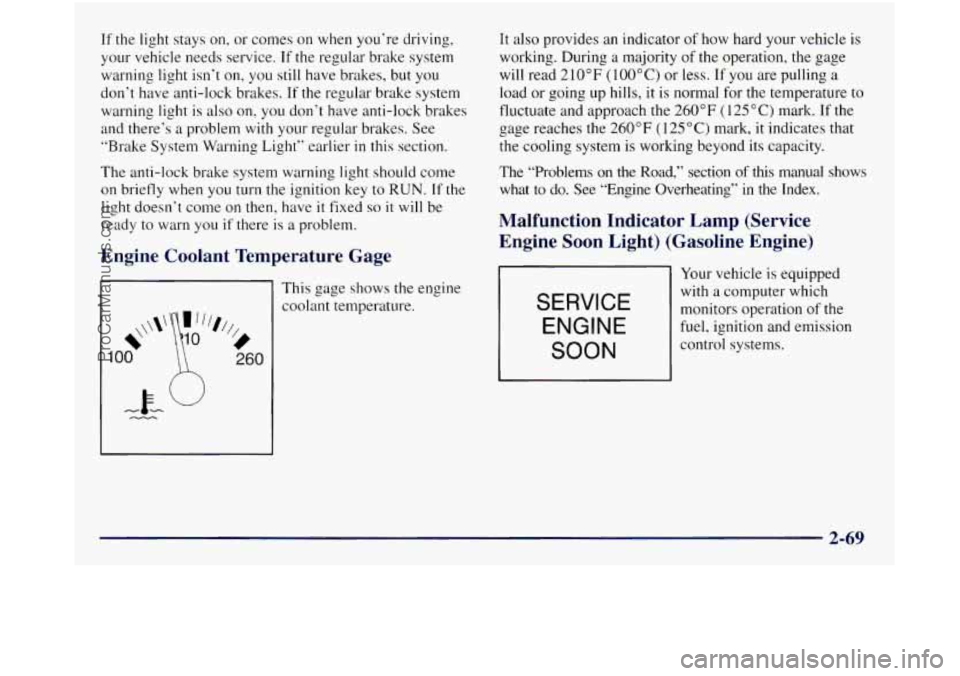
If the light stays on, or comes on when you’re driving,
your vehicle needs service.
If the regular brake system
warning light isn’t on, you still have brakes, but you
don’t have anti-lock brakes.
If the regular brake system
warning light is also on, you don’t have anti-lock brakes
and there‘s a problem
with your regular brakes. See
“Brake System Warning Light” earlier
in this section.
The anti-lock brake system warning light should come
on briefly when you turn the ignition key to RUN. If the
light doesn‘t come on then. have it fixed
so it will be
ready to warn you
if there is a problem.
Engine Coolant Temperature Gage
1
This gage shows the engine
coolant temperature.
It also provides an indicator of how hard your vehicle is
working. During a majority of the operation, the gage
will read
210°F (100°C) or less. If you are pulling a
load or going up hills, it is normal for the temperature to
fluctuate and approach the
260°F (1 25 “C) mark. If the
gage reaches the
260°F (125°C) mark, it indicates that
the cooling system is working beyond its capacity.
The “Problems on
the Road,” section of this manual shows
what
to do. See “Engine Overheating” in the Index.
Malfunction Indicator Lamp (Service
Engine
Soon Light) (Gasoline Engine)
SERVICE
ENGINE
SOON
Your vehicle is equipped
with a computer which
monitors operation
of the
fuel, ignition and emission
control systems.
2-69
ProCarManuals.com